Collaborative playlists on Spotify offer a unique way for multiple users to share and enjoy music together, making them perfect for social gatherings and shared experiences. To maximize their impact, it’s essential to promote these playlists through social media and music communities, attracting more contributors and listeners. Engaging your audience by fostering a sense of community and encouraging active participation can further enhance the collaborative experience.
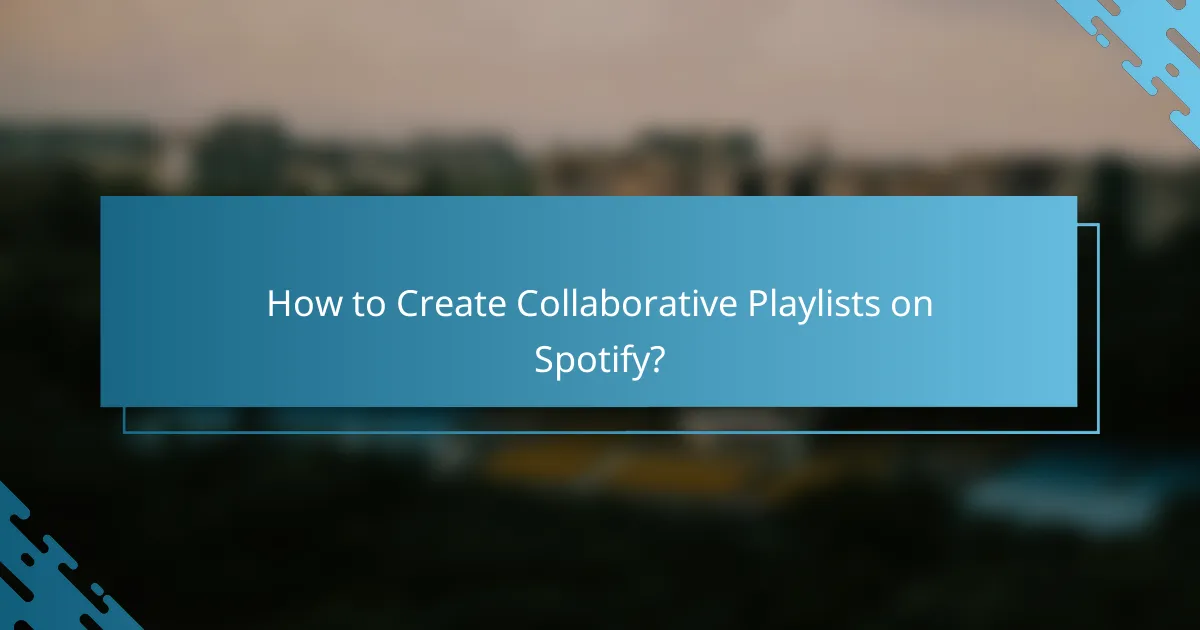
How to Create Collaborative Playlists on Spotify?
Creating collaborative playlists on Spotify allows multiple users to contribute songs, enhancing the music experience through shared tastes. This feature is ideal for parties, road trips, or any group setting where diverse music selections are appreciated.
Step-by-step creation process
To create a collaborative playlist on Spotify, start by opening the app and selecting “Your Library.” Tap on “Playlists,” then click on “Create Playlist.” After naming your playlist, you can make it collaborative by selecting the three dots in the playlist view and choosing “Invite collaborators.”
Once the playlist is set to collaborative, you can share it with friends via a link or directly through Spotify. This process is straightforward and can be completed in just a few minutes.
Inviting collaborators
Inviting collaborators to your playlist is simple. After creating the playlist, click on the three dots and select “Invite collaborators.” You can then share the link via messaging apps, email, or social media.
Make sure to communicate with your collaborators about the playlist’s theme or purpose to ensure a cohesive music selection. This can enhance the overall experience and keep contributions relevant.
Setting playlist permissions
When you create a collaborative playlist, you can control who can add or remove songs. By default, anyone with the link can edit the playlist, but you can choose to limit access if needed.
To manage permissions, go back to the playlist settings and adjust the collaboration options. This ensures that only trusted friends can modify the playlist, preventing unwanted changes.
Adding and removing songs
Collaborators can easily add or remove songs from the playlist. To add a song, search for it in Spotify, click on the three dots next to the track, and select “Add to Playlist,” then choose your collaborative playlist.
To remove a song, simply navigate to the playlist, find the track, click on the three dots next to it, and select “Remove from Playlist.” This flexibility allows for dynamic changes based on group preferences.
Using playlist descriptions
Adding a description to your collaborative playlist can provide context and enhance engagement. To do this, go to the playlist settings and enter a brief description that outlines the playlist’s theme or purpose.
A well-crafted description can guide collaborators in selecting appropriate songs and can make the playlist more appealing to listeners. Consider including details like the occasion or mood to inspire contributions.
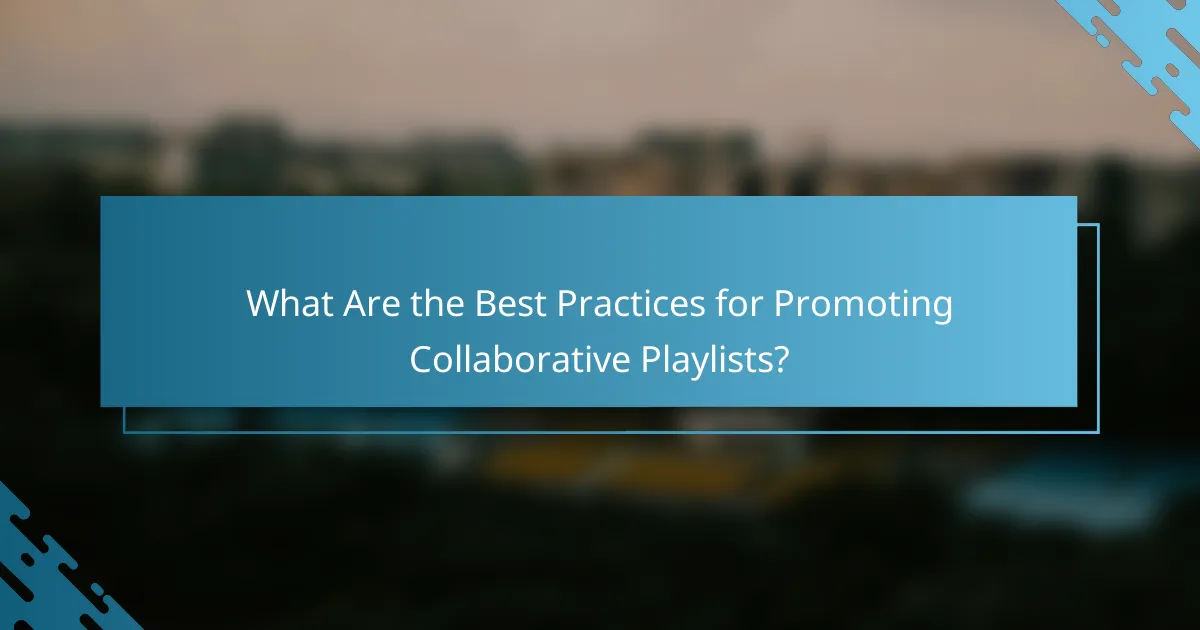
What Are the Best Practices for Promoting Collaborative Playlists?
Promoting collaborative playlists effectively involves leveraging various platforms and communities to increase visibility and engagement. By using social media, engaging with music enthusiasts, and collaborating with influencers, you can attract more listeners and contributors to your playlists.
Utilizing social media platforms
Social media is a powerful tool for promoting collaborative playlists. Share your playlists on platforms like Instagram, Twitter, and Facebook, using relevant hashtags to reach a broader audience. Create visually appealing posts or stories that highlight standout tracks or contributors to draw attention.
Consider running targeted ads to reach specific demographics interested in your playlist’s genre. Engaging with followers through polls or questions about their favorite songs can also foster a sense of community and encourage sharing.
Engaging with music communities
Participating in online music communities can significantly boost your playlist’s visibility. Join forums, subreddits, or Facebook groups dedicated to music discussions, where you can share your playlists and invite feedback. Make sure to follow community guidelines to avoid being seen as spammy.
Engagement is key; respond to comments and participate in discussions to build relationships. Consider hosting listening parties or collaborative events within these communities to create buzz around your playlist.
Collaborating with influencers
Partnering with music influencers can amplify your playlist’s reach. Identify influencers who align with your playlist’s genre and audience, and propose collaborations where they can share your playlist with their followers. This can be through shoutouts, features, or even co-curating a playlist together.
When collaborating, ensure that the influencer’s style and audience match your playlist’s vibe to maintain authenticity. Offering exclusive content or early access to new tracks can incentivize influencers to promote your playlist more enthusiastically.
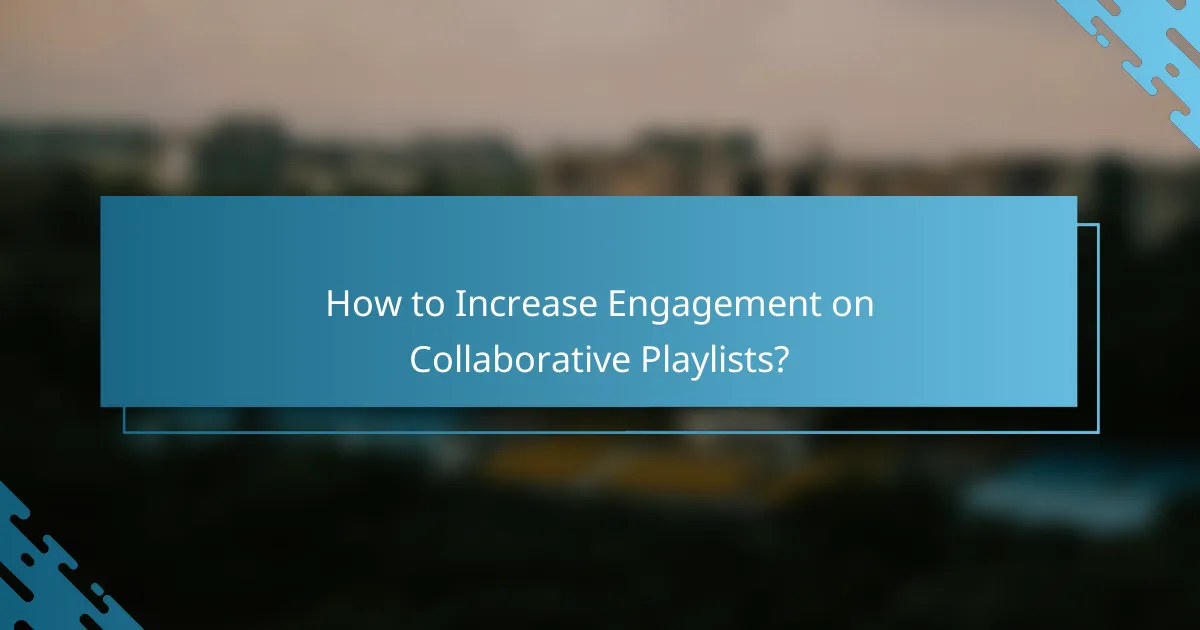
How to Increase Engagement on Collaborative Playlists?
To increase engagement on collaborative playlists, focus on fostering a sense of community and encouraging active participation. This can be achieved through user contributions, regular updates, and interactive events that keep listeners involved and invested in the playlist.
Encouraging user contributions
Encouraging user contributions is essential for enhancing engagement on collaborative playlists. Invite listeners to add their favorite tracks and share why they chose them, creating a personal connection to the music. Consider setting specific themes or genres for contributions to guide users and keep the playlist cohesive.
To motivate participation, you can highlight top contributors or feature their selections prominently. This recognition can foster a sense of ownership and pride, prompting more users to engage actively.
Regularly updating playlists
Regularly updating playlists keeps the content fresh and encourages listeners to return. Aim to refresh the playlist every few weeks or monthly, depending on the size of your audience and the volume of contributions. This can include adding new songs, removing less popular tracks, or even creating seasonal playlists.
Communicate updates to your audience through social media or messaging platforms to remind them of the changes. This not only keeps the playlist dynamic but also reinforces the community aspect as users see their contributions reflected in the updates.
Hosting listening parties
Hosting listening parties is an effective way to engage users and create a shared experience around your collaborative playlist. These events can be organized virtually via streaming platforms or in-person gatherings, depending on your audience’s preferences and location.
During a listening party, encourage participants to discuss their favorite tracks, share stories, or even suggest live edits to the playlist. This interactive format can significantly enhance community bonds and make users feel more connected to the playlist and each other.
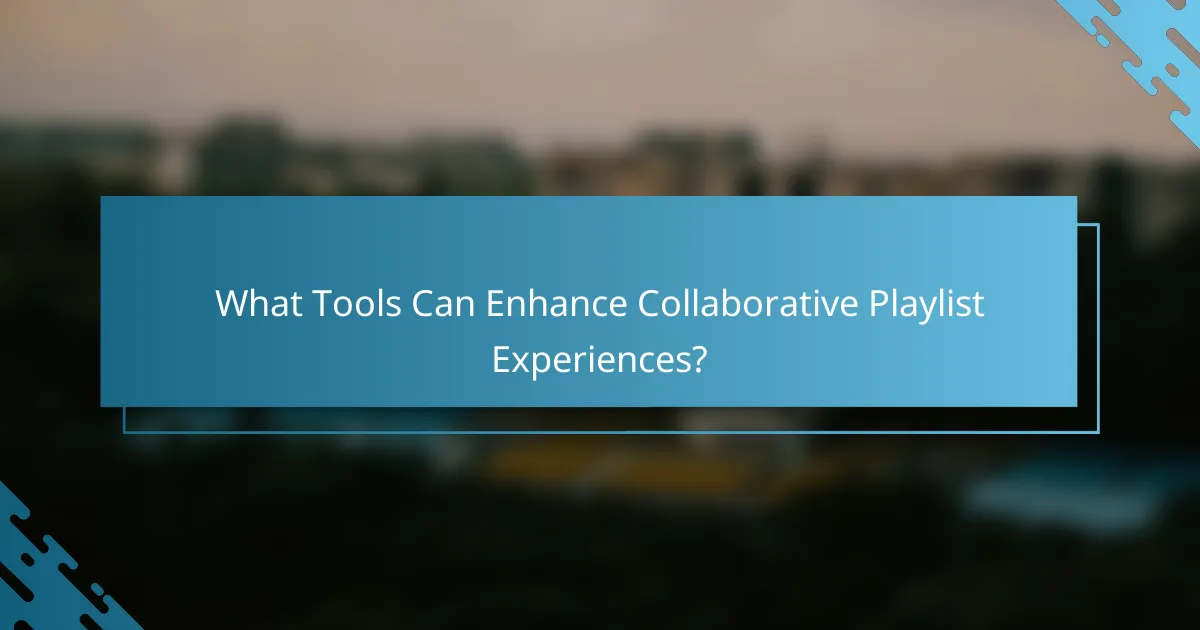
What Tools Can Enhance Collaborative Playlist Experiences?
Several tools can significantly improve collaborative playlist experiences by facilitating communication, music discovery, and engagement among users. Leveraging platforms that support these functionalities can lead to a more enjoyable and interactive music-sharing environment.
Using Discord for communication
Discord serves as an excellent platform for real-time communication among users collaborating on playlists. By creating dedicated channels for music discussions, users can share recommendations, discuss song choices, and even listen together through voice channels.
To maximize engagement, consider using Discord bots that can integrate with music services, allowing users to add songs directly to playlists from within the chat. This streamlines the process and keeps the conversation flowing without needing to switch apps.
Integrating with music discovery apps
Integrating music discovery apps can enhance the collaborative playlist experience by introducing users to new tracks that fit their collective tastes. Services like Spotify, Apple Music, or SoundCloud offer features that allow users to explore trending songs or personalized recommendations based on their listening habits.
When choosing a music discovery app, look for those that allow easy sharing and collaboration features. For instance, Spotify’s collaborative playlist option enables multiple users to add songs, making it simple to curate a diverse selection. Additionally, consider using apps that provide insights into song popularity or user engagement to help guide your playlist choices.
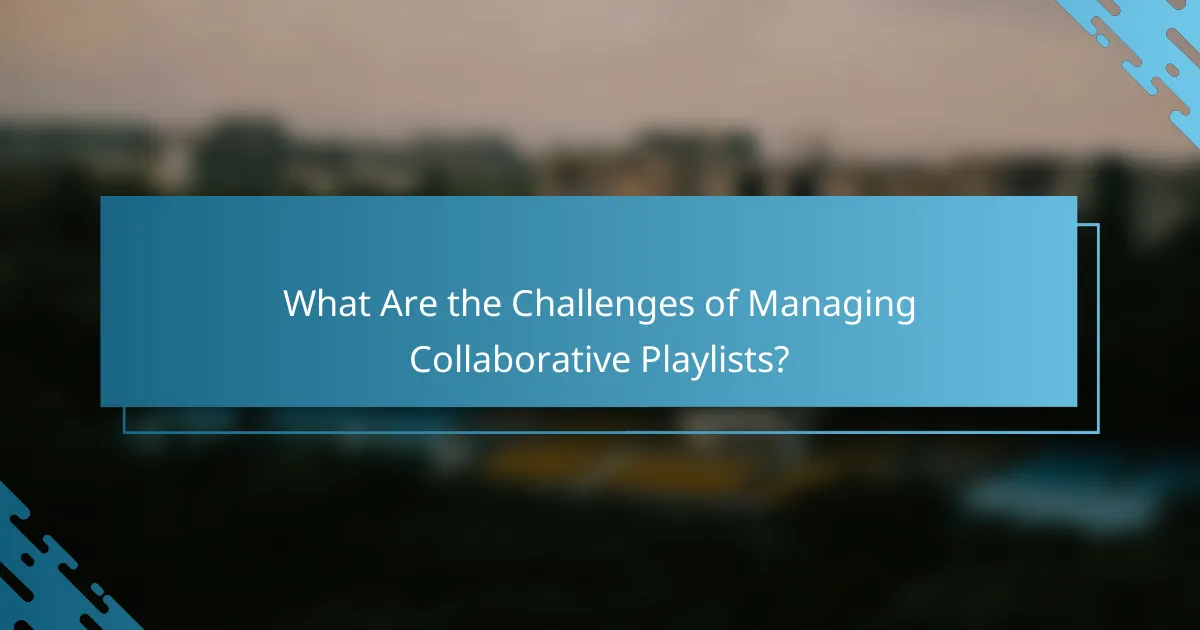
What Are the Challenges of Managing Collaborative Playlists?
Managing collaborative playlists involves navigating various challenges, including conflict resolution among collaborators and maintaining the overall quality of the playlist. These issues can impact user engagement and the enjoyment of shared music experiences.
Conflict resolution among collaborators
Conflicts can arise when collaborators have differing musical tastes or preferences for song selection. To effectively manage these disputes, it’s essential to establish clear guidelines for contributions and encourage open communication among all participants.
One effective approach is to implement a voting system where collaborators can suggest songs and then vote on which tracks to include. This democratic method can help ensure that everyone’s voice is heard while minimizing potential disagreements.
Maintaining playlist quality
Ensuring the quality of a collaborative playlist requires regular review and curation. Collaborators should periodically assess the playlist to remove tracks that may not resonate with the group or that have become outdated.
Setting specific criteria for song selection, such as genre relevance or popularity, can help maintain a cohesive listening experience. Additionally, encouraging feedback from all collaborators can foster a sense of ownership and investment in the playlist’s quality.
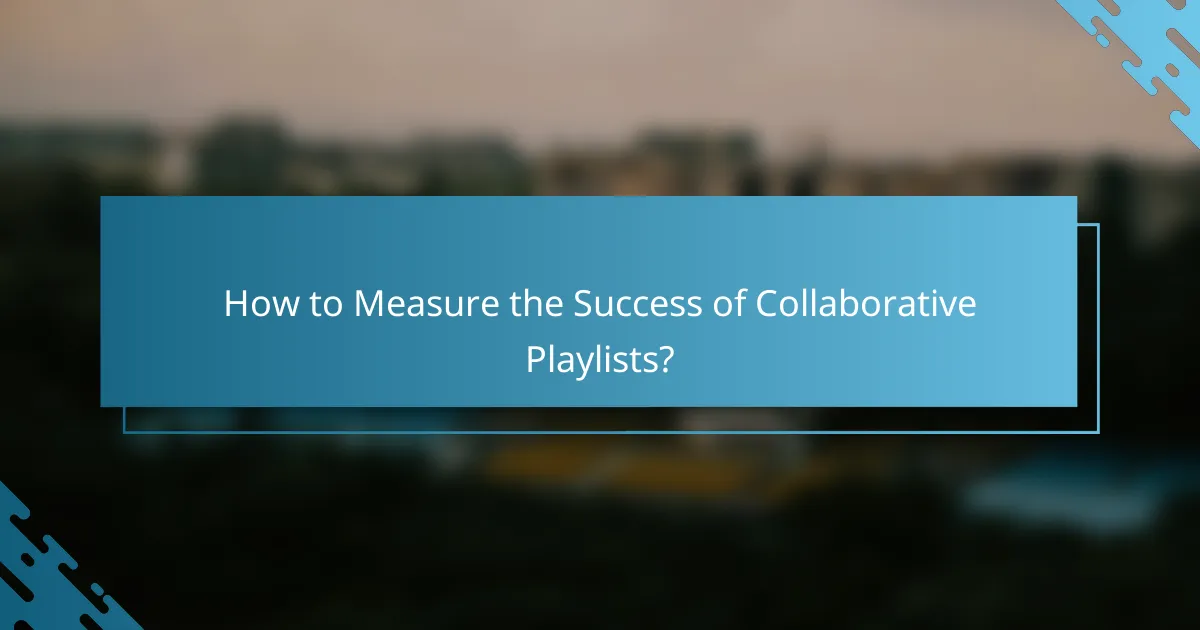
How to Measure the Success of Collaborative Playlists?
Measuring the success of collaborative playlists involves tracking engagement metrics, user contributions, and overall listener satisfaction. Key indicators include the number of active participants, the frequency of updates, and listener feedback.
Engagement Metrics
Engagement metrics are crucial for assessing how well a collaborative playlist resonates with its audience. Key metrics include the number of plays, skips, and shares. A successful playlist typically sees a high play count and low skip rate, indicating that listeners enjoy the selections.
Consider using analytics tools provided by streaming platforms to monitor these metrics over time. Regularly reviewing this data helps identify trends and areas for improvement, such as adjusting song choices or inviting new contributors.
User Contributions
User contributions reflect the level of collaboration and community involvement in the playlist. Track the number of songs added by different users, as well as the frequency of updates. A diverse range of contributors can enhance the playlist’s appeal and keep it fresh.
Encourage users to actively participate by promoting the playlist on social media or within relevant communities. Highlighting top contributors can also motivate others to engage and share their music preferences.
Listener Feedback
Listener feedback is vital for understanding the playlist’s impact. Collecting qualitative feedback through comments or surveys can provide insights into what listeners like or dislike. This feedback can guide future updates and help tailor the playlist to audience preferences.
Consider implementing a simple rating system or comment section for users to express their thoughts. Regularly reviewing this feedback allows for continuous improvement and fosters a sense of community among listeners.
